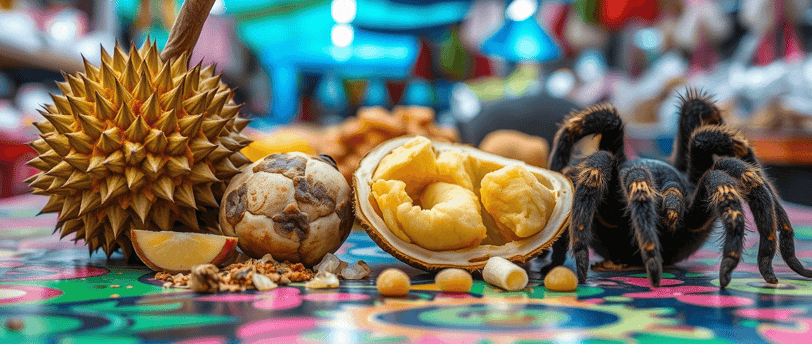Weird and Wonderful Foods You Absolutely Have to Try (If You Dare!)
Forget your usual meals! We explore some of the most unusual and interesting foods from around the world that might just surprise your taste buds.
TRAVEL
4/2/20254 min read


One of the most exciting parts of traveling is getting to experience new and different foods. While you might be tempted to stick to familiar dishes, stepping outside your culinary comfort zone can lead to some truly memorable and surprising experiences. The world is full of weird and wonderful foods, some of which might sound a little strange at first, but are considered delicacies in their respective cultures. If you're an adventurous eater, here are some unusual foods from around the globe that you absolutely have to try (if you dare!).
Let's start in Asia, where you can find some truly unique culinary creations. In many Southeast Asian countries, like Thailand and Vietnam, you might come across fried insects. Yes, you read that right. Grasshoppers, crickets, ants, and even scorpions are often deep-fried and seasoned, making for a crunchy and surprisingly tasty snack. They are a good source of protein and are a popular street food. While the idea of eating bugs might seem strange to some, they are a common part of the diet in many parts of the world.
Moving to Japan, you might encounter natto. This is a dish made from fermented soybeans. It has a very strong, pungent smell and a sticky, slimy texture that many people find off-putting. However, natto is considered very healthy and is a popular breakfast food in Japan. It's often eaten with rice and soy sauce. Trying natto is definitely an experience, and while it might not be for everyone, it's a unique part of Japanese cuisine.
In Iceland, you might come across hákarl. This is fermented shark meat that has been buried underground for several months. The fermentation process gives it a very strong ammonia smell and taste. Hákarl is considered a traditional Icelandic dish and is often eaten during festivals. It's definitely an acquired taste, and even Icelanders sometimes find it strong. It's often recommended to try it with a shot of Brennivín, a local spirit.
Across the Atlantic in Scotland, you might encounter haggis. This is a savory pudding containing sheep's pluck (heart, liver, and lungs), minced with onion, oatmeal, suet (animal fat), spices, and stock. It's traditionally encased in the sheep's stomach, though modern versions often use artificial casings. Haggis is considered the national dish of Scotland and is often served with "neeps and tatties" (mashed turnips and potatoes). It has a rich, peppery flavor and a somewhat crumbly texture.
In Sardinia, Italy, there's a cheese called casu marzu. This cheese is made from sheep's milk and is intentionally infested with live insect larvae. Yes, you read that correctly. The larvae digest the fats in the cheese, giving it a very strong and unique flavor. Casu marzu is considered a delicacy by some but is actually illegal to sell in Italy due to health concerns. If you ever get the chance to try it (discreetly, of course), it's certainly an unforgettable culinary experience.
Moving to Southeast Asia again, specifically the Philippines, you might find balut. This is a fertilized duck embryo that is boiled and eaten in the shell. It contains a partially developed duck fetus. Balut is considered a high-protein snack and is often sold by street vendors. It's a popular food among locals, but the appearance might be off-putting to some Westerners.
In China, you might encounter century eggs (also known as preserved eggs or hundred-year eggs). Despite the name, they are not actually a hundred years old. They are made by preserving duck, chicken, or quail eggs in a mixture of clay, ash, salt, quicklime, and rice hulls for several weeks to several months. The yolk turns dark green or even black, and the white becomes a dark brown jelly-like substance. Century eggs have a strong, sulfurous smell and a unique flavor. They are often eaten as an appetizer or as part of other dishes.
These are just a few examples of the many weird and wonderful foods you can find around the world. Trying these kinds of foods can be a great way to learn about different cultures and expand your palate. It might feel a little strange at first, but you might just discover a new favorite dish.
Of course, not everyone is going to be adventurous enough to try all of these foods. And that's perfectly okay. The point is to be open to new experiences and to step outside your comfort zone when you travel. You never know what culinary delights you might discover.
When you are trying new and unusual foods, it's always a good idea to do a little research beforehand. Find out what the food is, how it's prepared, and what to expect in terms of taste and texture. It's also a good idea to try these foods in reputable places to ensure they are prepared safely.
Trying weird and wonderful foods can be a fun and memorable part of your travels. It's a way to connect with the local culture and to have stories to tell when you get back home. So, the next time you are planning a trip, why not look up some of the local delicacies that might sound a little unusual? You might just surprise yourself and discover a new favorite food that you never would have expected. Just remember to be open-minded and have a sense of adventure!
Explore
Discover fascinating articles on interesting topics daily.
Engage
© 2025. All rights reserved.
